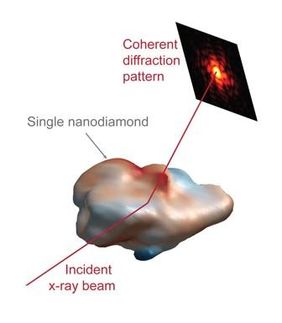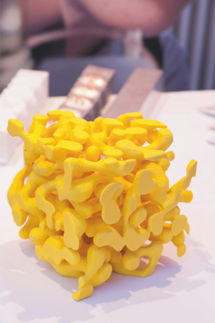University of Pennsylvania Researchers Demonstrate a Flexible, One-Step Assembly of Nanoscale Structures
Scientists at the University of Pennsylvania have created a one-step, repeatable method for the production of functional nanoscale patterns or motifs with adjustable features, size and shape using a single master "plate."
Researchers took advantage of the elastic instability of a widely used, flexible polymer membrane, polydimethylsiloxane, or PDMS. When exposed to a solvent, circular pores in the membrane elliptically deform, and elastic interactions between them generate long-range orientational order of their axes into a "diamond plate" pattern. By lacing the solvent with iron nanoparticles, the team found that evaporation of the solvent drives the assembly of the nanoparticles onto the membrane surface along these distorted pores.
This results in two-dimensional patterns with sub-100 nanometer features. The traditional fabrication process can take as long as a month and cost $50,000 per print. In this new process, a master can be made for a fraction of the cost and can be reused many times. The Penn team's technique does not require delicate surface preparation or the complex chemistry of standard lithographic processes. Instead, the new process relies on patterns that form spontaneously in equilibrium. The resulting, "diamond-plate" pattern persists over the entire sample, as large as a square centimeter, with no imperfections.
The features of the resultant nanoparticle patterns are up to 10 times sharper than the original membrane. The resulting symmetry of the film can be transferred onto a substrate, both flat or curved, where it can be used to generate similar anisotropic magnetic, photonic, phononic and plasmonic properties.
"These functional nano-motifs could in turn benefit novel technologies that are sensitive to local environment change such as smart clothing, biomarkers and eco-friendly buildings," Shu Yang, assistant professor in the Department of Materials Science and Engineering of the School of Engineering and Applied Science at Penn, said. "Using similar pattern transformation principles, our technique could be extended to pattern a variety of material systems such as polymers and composites, creating a new design mechanism for nanoscale manufacturing."
The team modeled the elastic instability of the membrane in terms of elastically interacting "dislocation dipoles" and found complete agreement between the theoretical ground state and the observed pattern. This model allows for the manipulation of the structural details of the membrane to tailor the elastic distortions and generate a variety of nanostructures.
"It is both surprising and serendipitous that the simple theory is corroborated by experiment and by complex numerical simulations by other groups," Randall Kamien, professor in the Department of Physics and Astronomy in the School of Arts and Sciences at Penn, said.
PDMS membranes have been widely used in soft lithography for low-cost fabrication of microdevices. The Penn team replica-molded a PDMS membrane with circular pores from an array of 1 m diameter silicon pillars spaced 2 m apart on a square lattice. When exposed to the organic solvent toluene, PDMS gels swell by as much as 130 percent. As the osmotic pressure builds, the circular pores in the PDMS deform and eventually snap shut to relieve the stress, much as the joints in railways and bridges expand and contract to maintain structural integrity in response to changes in moisture and temperature.
Because the elastic deformation of the PDMS membrane is induced by solvent swelling, the diamond plate pattern in PDMS is stable in the wet state and snaps back to the original square lattice once the solvent evaporates. To capture the diamond plate before evaporation and, more important, to utilize this deformation for assembly of complex functional structures, the team suspended superparamagnetic Fe3O4 nanoparticles in toluene and applied the solution to the PDMS membrane. As the PDMS swells, the convective assembly of the nanoparticles follows, faithfully replicating the deformed PDMS membrane. Once dry, the elastic membrane returns to its original state and can be reused.
Topics
Organizations
Other news from the department science

Get the analytics and lab tech industry in your inbox
By submitting this form you agree that LUMITOS AG will send you the newsletter(s) selected above by email. Your data will not be passed on to third parties. Your data will be stored and processed in accordance with our data protection regulations. LUMITOS may contact you by email for the purpose of advertising or market and opinion surveys. You can revoke your consent at any time without giving reasons to LUMITOS AG, Ernst-Augustin-Str. 2, 12489 Berlin, Germany or by e-mail at revoke@lumitos.com with effect for the future. In addition, each email contains a link to unsubscribe from the corresponding newsletter.






















































